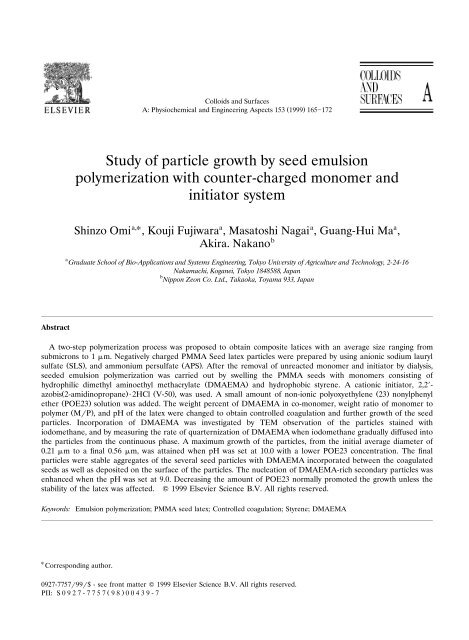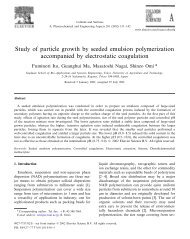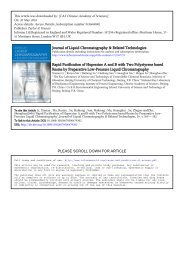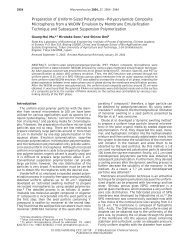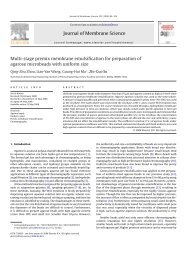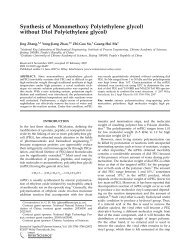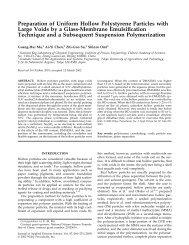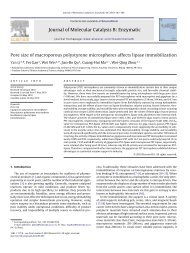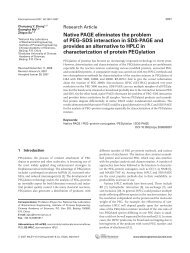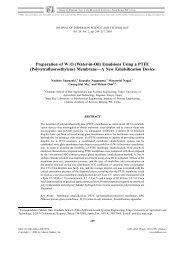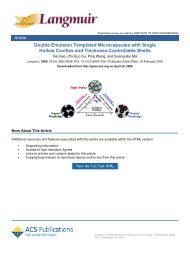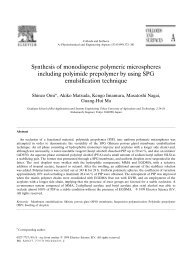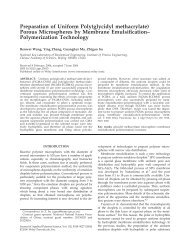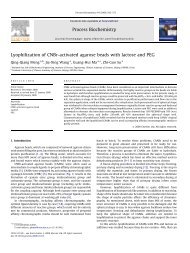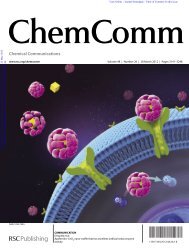Study of particle growth by seed emulsion polymerization with ...
Study of particle growth by seed emulsion polymerization with ...
Study of particle growth by seed emulsion polymerization with ...
You also want an ePaper? Increase the reach of your titles
YUMPU automatically turns print PDFs into web optimized ePapers that Google loves.
Colloids and Surfaces<br />
A: Physiochemical and Engineering Aspects 153 Ž 1999.<br />
165172<br />
<strong>Study</strong> <strong>of</strong> <strong>particle</strong> <strong>growth</strong> <strong>by</strong> <strong>seed</strong> <strong>emulsion</strong><br />
<strong>polymerization</strong> <strong>with</strong> counter-charged monomer and<br />
initiator system<br />
Shinzo Omi a, , Kouji Fujiwara a , Masatoshi Nagai a , Guang-Hui Ma a ,<br />
Akira. Nakano b<br />
a Graduate School <strong>of</strong> Bio-Applications and Systems Engineering, Tokyo Uniersity <strong>of</strong> Agriculture and Technology, 2-24-16<br />
Nakamachi, Koganei, Tokyo 1848588, Japan<br />
b Nippon Zeon Co. Ltd., Takaoka, Toyama 933, Japan<br />
Abstract<br />
A two-step <strong>polymerization</strong> process was proposed to obtain composite latices <strong>with</strong> an average size ranging from<br />
submicrons to 1 m. Negatively charged PMMA Seed latex <strong>particle</strong>s were prepared <strong>by</strong> using anionic sodium lauryl<br />
sulfate Ž SLS ., and ammonium persulfate Ž APS .. After the removal <strong>of</strong> unreacted monomer and initiator <strong>by</strong> dialysis,<br />
<strong>seed</strong>ed <strong>emulsion</strong> <strong>polymerization</strong> was carried out <strong>by</strong> swelling the PMMA <strong>seed</strong>s <strong>with</strong> monomers consisting <strong>of</strong><br />
hydrophilic dimethyl aminoethyl methacrylate Ž DMAEMA.<br />
and hydrophobic styrene. A cationic initiator, 2,2azobisŽ<br />
2-amidinopropane. 2HCl Ž V-50 ., was used. A small amount <strong>of</strong> non-ionic polyoxyethylene Ž 23.<br />
nonylphenyl<br />
ether Ž POE23.<br />
solution was added. The weight percent <strong>of</strong> DMAEMA in co-monomer, weight ratio <strong>of</strong> monomer to<br />
polymer Ž MP ., and pH <strong>of</strong> the latex were changed to obtain controlled coagulation and further <strong>growth</strong> <strong>of</strong> the <strong>seed</strong><br />
<strong>particle</strong>s. Incorporation <strong>of</strong> DMAEMA was investigated <strong>by</strong> TEM observation <strong>of</strong> the <strong>particle</strong>s stained <strong>with</strong><br />
iodomethane, and <strong>by</strong> measuring the rate <strong>of</strong> quarternization <strong>of</strong> DMAEMA when iodomethane gradually diffused into<br />
the <strong>particle</strong>s from the continuous phase. A maximum <strong>growth</strong> <strong>of</strong> the <strong>particle</strong>s, from the initial average diameter <strong>of</strong><br />
0.21 m to a final 0.56 m, was attained when pH was set at 10.0 <strong>with</strong> a lower POE23 concentration. The final<br />
<strong>particle</strong>s were stable aggregates <strong>of</strong> the several <strong>seed</strong> <strong>particle</strong>s <strong>with</strong> DMAEMA incorporated between the coagulated<br />
<strong>seed</strong>s as well as deposited on the surface <strong>of</strong> the <strong>particle</strong>s. The nucleation <strong>of</strong> DMAEMA-rich secondary <strong>particle</strong>s was<br />
enhanced when the pH was set at 9.0. Decreasing the amount <strong>of</strong> POE23 normally promoted the <strong>growth</strong> unless the<br />
stability <strong>of</strong> the latex was affected. 1999 Elsevier Science B.V. All rights reserved.<br />
Keywords: Emulsion <strong>polymerization</strong>; PMMA <strong>seed</strong> latex; Controlled coagulation; Styrene; DMAEMA<br />
<br />
Corresponding author.<br />
0927-775799$ - see front matter 1999 Elsevier Science B.V. All rights reserved.<br />
Ž .<br />
PII: S 0 9 2 7 - 7 7 5 7 9 8 0 0 4 3 9 - 7
166<br />
( )<br />
S. Omi et al. Colloids Surfaces A: Physiochem. Eng. Aspects 153 1999 165172<br />
1. Introduction<br />
Composite latices, modified <strong>with</strong> hydrophilic<br />
components, have been applied to outdoor paints<br />
which resist the deposition <strong>of</strong> oily contaminants<br />
in precipitations, cardboard paints, and so forth.<br />
Also, a new designing concept, a sophisticated<br />
coagulation process leading to a controlled size<br />
distribution, successfully delayed the shear thinning<br />
at the higher shear region, resisting paints to<br />
drip down when brushed on a vertical surface. A<br />
controlled coagulation <strong>of</strong> polymer <strong>particle</strong>s <strong>by</strong><br />
incorporating an appropriate amount <strong>of</strong> watersoluble<br />
polymers in the <strong>particle</strong>s was tried for a<br />
commercial product which provided a deft relieflike<br />
pattern as a finishing paint while retaining<br />
the above rheological pr<strong>of</strong>ile 1 . For a thick coating,<br />
only one coating is necessary compared to a<br />
repeated brushing <strong>by</strong> using a conventional polyvinylacetate<br />
Ž VAc-Veova.<br />
paint. Each primary<br />
polymer <strong>particle</strong> has a diameter between 0.1 and<br />
1.0 m, finally growing up to a broad size distribution<br />
from 1.0 to 4.0 m <strong>by</strong> a controlled<br />
coagulation process during the <strong>polymerization</strong>.<br />
The unique water-soluble polymer is partly composed<br />
<strong>of</strong> non-electrolyte acryl amide, weak electrolytes<br />
such as acrylic or methacrylic acid, and<br />
the rest composed <strong>of</strong> strong electrolytes such as<br />
styrene sulfonic acid, sodium salt. The SEM photographs<br />
revealed two-dimensional, cluster-like,<br />
and non-spherical coagulums <strong>with</strong> the size distribution<br />
described above.<br />
In this study, we will propose a different procedure<br />
which yield spherical coagulated <strong>particle</strong>s <strong>by</strong><br />
employing a <strong>seed</strong>ed <strong>emulsion</strong> <strong>polymerization</strong> in<br />
which negatively charged <strong>seed</strong> <strong>particle</strong>s are<br />
swollen <strong>with</strong> a co-monomer composed <strong>of</strong> hydrophobic<br />
styrene Ž ST.<br />
and 520% <strong>of</strong> hydrophilic<br />
dimethylaminoethyl methacrylate Ž DMAEMA .,<br />
and then polymerized <strong>by</strong> a cationic initiator <strong>of</strong><br />
2,2-azobisŽ 2-amizinopropane. 2HCl Ž V-50 .. A<br />
hydrophilic portion can be incorporated either <strong>by</strong><br />
coagulation or during the <strong>seed</strong> <strong>polymerization</strong>. By<br />
changing the composition and the size <strong>of</strong> the <strong>seed</strong><br />
polymer <strong>particle</strong>s, DMAEMA content in the comonomer,<br />
and pH <strong>of</strong> the reaction mixture, the<br />
final <strong>particle</strong> size and distribution can be controlled.<br />
In this article, the results obtained from<br />
polymethyl methacrylate Ž PMMA.<br />
<strong>seed</strong> latex will<br />
be reported as an introduction <strong>of</strong> our procedure.<br />
Further results obtained <strong>by</strong> using modified <strong>seed</strong><br />
latices, PŽ MMA-co-styrene ., PŽMMA-co-butyl<br />
acrylate ., and PŽ MMA-co-2-ethylhexyl acrylate .,<br />
will follow including an effect <strong>of</strong> agitation during<br />
the <strong>seed</strong> <strong>polymerization</strong>.<br />
2. Experimental<br />
2.1. Materials<br />
Styrene Ž ST. and methyl methacrylate Ž MMA.<br />
Ž Kishida Chemical Co. . were commercial grade,<br />
distilled under reduced pressure, and stored in a<br />
refrigerator prior to use. Dimethyl aminoethyl<br />
methacrylate Ž DMAEMA, Tokyo Chemical Co. .<br />
was reagent grade and used as received.<br />
Ammonium persulfate ŽAPS, Wako Pure<br />
Chemical Co. . was used for the <strong>emulsion</strong> <strong>polymerization</strong>s<br />
to prepare PMMA <strong>seed</strong> latices.<br />
2,2-AzobisŽ 2-amidinopropane. 2HCl ŽV-50,<br />
Wako Pure Chemical Co. . was used for the <strong>seed</strong>ed<br />
<strong>emulsion</strong> <strong>polymerization</strong>s. They were reagent<br />
grade and used as received.<br />
Sodium lauryl sulfate Ž SLS, Merck.<br />
was used<br />
for the <strong>emulsion</strong> <strong>polymerization</strong>s to prepare<br />
PMMA <strong>seed</strong> latices. Polyoxyethylene nonylphenylether<br />
<strong>with</strong> 23 units <strong>of</strong> ethylene oxide<br />
Ž POE23, Kao Co. . was used for the <strong>seed</strong>ed <strong>emulsion</strong><br />
<strong>polymerization</strong>s to stabilize swollen <strong>particle</strong>s.<br />
They were reagent grade and used as received.<br />
A chain transfer agent, t-dodecyl mercaptan<br />
Ž TDM, Tokyo Chemical Co. ., was used as received.<br />
Methanol, ethanol, and tetrahydr<strong>of</strong>uran Ž THF.<br />
Ž Kishida Chemical Co. . were all commercial grade<br />
and used as received.<br />
Iodomethane Ž Tokyo Chemical Co. . was<br />
reagent grade and used as received for the quarternization<br />
<strong>of</strong> amino groups in DMAEMA.<br />
2.2. Polymerization apparatus<br />
A flat-bottom glass separator flask, either 500-<br />
or 1000-ml capacity, was used as a <strong>polymerization</strong><br />
reactor. A nitrogen inlet, a condenser, a thermocouple,<br />
and a feeder for initiator solution were
( )<br />
S. Omi et al. Colloids Surfaces A: Physiochem. Eng. Aspects 153 1999 165172 167<br />
equipped on the top <strong>of</strong> the flask. The nitrogen<br />
was released from the top <strong>of</strong> the condenser. A<br />
semi-circular flat blade was equipped as an impeller.<br />
The agitation rate was kept at 350 min 1<br />
for the preparation <strong>of</strong> PMMA <strong>seed</strong> latices, and<br />
240 min 1 for the <strong>seed</strong>ed <strong>polymerization</strong>s. The<br />
reactor was immersed in a thermostat controlled<br />
at 333 K during the <strong>polymerization</strong>.<br />
2.3. Preparation <strong>of</strong> PMMA <strong>seed</strong> latex<br />
Four <strong>seed</strong> latices <strong>of</strong> different <strong>particle</strong> size were<br />
prepared for all the investigations. MMA Ž 300 g.<br />
dissolving 0.5 g <strong>of</strong> TDM was dispersed in 700 ml<br />
<strong>of</strong> 0.3 wt.% SLS aqueous solution in a 1000-ml<br />
separator flask. Nitrogen gas was gently bubbled<br />
through the dispersion for 1 h whilst the temperature<br />
was gradually raised to 333 K. APS solution<br />
Ž 20 ml ., after a thorough bubbling <strong>by</strong> nitrogen,<br />
was added in the reactor. The <strong>polymerization</strong> was<br />
carried out for 3 h at 333 K under a nitrogen<br />
atmosphere. The average diameter <strong>of</strong> the <strong>seed</strong>s<br />
were changed <strong>by</strong> changing the amount <strong>of</strong> APS.<br />
The details <strong>of</strong> data are shown in Table 1.<br />
2.4. Seeded <strong>polymerization</strong><br />
The <strong>seed</strong> latex was filled in Visking membranes,<br />
dialyzed overnight under the tap water,<br />
and then immersed in distilled water for 10 h. A<br />
weighed amount <strong>of</strong> the <strong>seed</strong> latex containing 40 g<br />
<strong>of</strong> the solid was mixed <strong>with</strong> an aqueous solution<br />
<strong>of</strong> POE23 so that the total weight will be 340, 320<br />
or 300 ml depending on a selected monomer to<br />
<strong>seed</strong> polymer ratio Ž MP .. Under agitation <strong>by</strong> a<br />
magnet bar, 40, 60 or 80 g <strong>of</strong> the co-monomer<br />
consisting <strong>of</strong> ST and DMAEMA was added, and<br />
the agitation was continued at room temperature<br />
for 30 min. A 380-g sample <strong>of</strong> the mixture was<br />
transferred in a 500-ml separator flask. During<br />
the nitrogen bubbling for 1 h and the subsequent<br />
heating to the reaction temperature for 30 min,<br />
the <strong>seed</strong> polymer <strong>particle</strong>s were allowed to swell<br />
<strong>by</strong> absorbing the monomers. After 20 ml <strong>of</strong> the<br />
initiator solution was added, the <strong>polymerization</strong><br />
was carried out for 24 h at 333 K. The total<br />
weight was fixed as 400 g. After the <strong>polymerization</strong>,<br />
the final monomer conversion was measured<br />
gravimetrically. Polymers in a weighed latex sample<br />
were precipitated <strong>by</strong> using methanol, centrifuged,<br />
washed several times, and dried in a<br />
vacuum oven.<br />
2.5. Quarternization <strong>of</strong> DMAEMA<br />
Ten microliters <strong>of</strong> the dialyzed latex was added<br />
in a 100-ml triangle flask and diluted <strong>with</strong> a<br />
known amount <strong>of</strong> water. As the stoppered flask<br />
was stirred continuously <strong>with</strong> a magnet tip, an<br />
excess amount <strong>of</strong> methyl iodide dissolved in<br />
methanol was added in a certain interval. Moles<br />
<strong>of</strong> iodide ion liberated from the quarternization<br />
<strong>of</strong> DMAEMA was measured <strong>by</strong> an ion meter<br />
Ž Custany LAB, Horiba ., and the rate <strong>of</strong> quarternization<br />
<strong>of</strong> DMAEMA in the polymer <strong>particle</strong>s<br />
was estimated 2 .<br />
2.6. Analysis<br />
Average diameters <strong>of</strong> the polymer <strong>particle</strong>s<br />
were measured <strong>by</strong> counting 200 <strong>particle</strong>s in SEM<br />
Ž SM-35CF II-A, JEOL.<br />
photographs. Morphologies<br />
<strong>of</strong> the polymer <strong>particle</strong>s were observed from<br />
TEM photographs <strong>of</strong> stained ultra-thin microtomed<br />
samples. The polymer <strong>particle</strong>s were sealed<br />
in epoxy resins. The michrotomed samples were<br />
Table 1<br />
Properties <strong>of</strong> <strong>seed</strong> PMMA latex<br />
Run no. Average Coefficient <strong>of</strong> Number <strong>of</strong> polymer Zeta- Tg<br />
diameter Ž m. variation Ž %. 16 3<br />
<strong>particle</strong>s Ž 10 dm . potential Ž mV. Ž K.<br />
1502 0.21 5.74 7.22 No data No data<br />
1503 0.26 4.84 3.20 No data 394<br />
1504 0.18 4.86 9.15 60.0 394<br />
1508 0.21 6.45 6.03 88.7 394
168<br />
( )<br />
S. Omi et al. Colloids Surfaces A: Physiochem. Eng. Aspects 153 1999 165172<br />
exposed to the vapor <strong>of</strong> methyl iodide, and then<br />
observed <strong>by</strong> a TEM ŽH-700H and H-7000, Hitachi<br />
..<br />
Average molecular weights Ž M and M .<br />
w<br />
n were<br />
calculated from MWD curves obtained <strong>by</strong> GPC<br />
Ž HLC-8020, Toso .. Tetrahydr<strong>of</strong>uran was used as<br />
an eluant.<br />
The latex sample was diluted to 10 5 10 6 -fold,<br />
and the -potential <strong>of</strong> the polymer <strong>particle</strong>s was<br />
measured <strong>by</strong> a zeta potential analyzer ŽZeecom<br />
IP-140A, Michrotech Nichion Co. Ltd. ..<br />
3. Results and discussion<br />
3.1. PMMA <strong>seed</strong> latex<br />
The properties <strong>of</strong> the PMMA <strong>seed</strong> latex are<br />
shown in Table 1. The average diameters are 0.18,<br />
0.21 and 0.26 m. Corresponding to the use <strong>of</strong><br />
anionic APS and SLS, -potential revealed fairly<br />
high negative values.<br />
3.2. Deelopment <strong>of</strong> coagulation<br />
A typical course <strong>of</strong> the coagulative process is<br />
shown in Fig. 1 where the average diameter and<br />
the number <strong>of</strong> polymer <strong>particle</strong>s are plotted<br />
against the polymer yield. A marked increase <strong>of</strong><br />
the average diameter was observed in the initial<br />
stage <strong>of</strong> <strong>polymerization</strong>, followed <strong>by</strong> a plateau,<br />
and a dramatic increase in the final stage. The<br />
number <strong>of</strong> polymer <strong>particle</strong>s was calculated from<br />
the average diameter and the polymer yield, and<br />
its decrease in the initial stage implied that the<br />
increase in the average diameter was not only due<br />
to the <strong>growth</strong> <strong>of</strong> each <strong>seed</strong> polymer <strong>particle</strong> but<br />
mainly due to the considerable coagulation<br />
between the <strong>particle</strong>s. The subsequent plateau<br />
may indicate that the <strong>polymerization</strong> proceeded<br />
<strong>by</strong> consuming the swollen monomers in the polymer<br />
<strong>particle</strong>s. The final <strong>particle</strong> size is definitely<br />
controlled <strong>by</strong> the intensive coagulation, which<br />
started approx. 50% monomer conversion, and<br />
seemed to correspond to an onset <strong>of</strong> the Trommsdorff<br />
effect. A simple calculation implies each<br />
final <strong>particle</strong> is an aggregate <strong>of</strong> 3.3 <strong>seed</strong> <strong>particle</strong>s.<br />
It can be said that the coagulation between the<br />
<strong>particle</strong>s will progress affected <strong>by</strong> the intensity <strong>of</strong><br />
Fig. 1. Progress <strong>of</strong> coagulation.<br />
agitation as well as the electrostatic attraction<br />
force. In this article, the investigation was focused<br />
on the latter effect, keeping the agitation rate at<br />
a constant 240 min 1 . The effect <strong>of</strong> agitation<br />
during the <strong>polymerization</strong> will be discussed in the<br />
next article <strong>by</strong> using a low Tg <strong>seed</strong> <strong>particle</strong>s,<br />
PŽ MMA-co-2EHA ., in which a more intensive<br />
Ž yet well controlled. coagulation was observed 3 .<br />
A coagulation mechanism will be proposed after<br />
all the experimental data were shown.<br />
3.3. Effect <strong>of</strong> DMAEMA content in monomer<br />
SEM photographs <strong>of</strong> the PMMA <strong>seed</strong> Ž 1503 .,<br />
and the final polymer <strong>particle</strong>s <strong>with</strong> different content<br />
<strong>of</strong> DMAEMA in monomer are shown in Fig.<br />
2. The monomer to polymer ratio Ž MP.<br />
was 2.0.<br />
The final <strong>particle</strong> size increased <strong>with</strong> increasing<br />
content <strong>of</strong> DMAEMA, and attained a maximum<br />
<strong>of</strong> 0.60 m at 15% DMAEMA content. As shown<br />
in the photographs, the coefficient <strong>of</strong> variation<br />
became higher, from 4.84% <strong>of</strong> the <strong>seed</strong> to 10.3%<br />
Ž 511, 5% DMAEMA ., 11.8% Ž 509, 10% ., and<br />
12.4% Ž 510, 15% ., indicating uneven coagulation<br />
and <strong>growth</strong> <strong>of</strong> the polymer <strong>particle</strong>s.<br />
3.4. Effect <strong>of</strong> monomer to polymer weight ratio<br />
( ) MP<br />
Effect <strong>of</strong> the monomer to polymer ratio to the<br />
volumetric <strong>growth</strong> <strong>of</strong> the polymer <strong>particle</strong>s, and to
( )<br />
S. Omi et al. Colloids Surfaces A: Physiochem. Eng. Aspects 153 1999 165172 169<br />
Fig. 2. SEM photographs <strong>of</strong> the final <strong>particle</strong>s <strong>with</strong> different DMAEMA content in monomer. Seed PMMA latex is shown as a<br />
reference.<br />
Fig. 3. Final <strong>growth</strong> <strong>of</strong> polymer <strong>particle</strong>s as a function <strong>of</strong> DMAEMA content in monomer.
170<br />
( )<br />
S. Omi et al. Colloids Surfaces A: Physiochem. Eng. Aspects 153 1999 165172<br />
the coagulation number <strong>of</strong> the <strong>seed</strong> <strong>particle</strong>s are<br />
shown in Fig. 3 as a function <strong>of</strong> the DMAEMA<br />
content in monomer. The relative <strong>growth</strong> in Fig.<br />
3a is defined as the volumetric ratio <strong>of</strong> the final<br />
<strong>particle</strong>s to the <strong>seed</strong>s Ž d .<br />
pd s<br />
3 , overlapping the<br />
two effects; the <strong>growth</strong> <strong>by</strong> the <strong>polymerization</strong> <strong>of</strong><br />
monomer and the coagulation between the <strong>seed</strong><br />
<strong>particle</strong>s. On the other hand, the coagulation<br />
number, NN s, solely estimates the intensity <strong>of</strong><br />
coagulation. dp<br />
and ds<br />
are the average diameters<br />
<strong>of</strong> the final <strong>particle</strong>s and the <strong>seed</strong>s, respectively,<br />
and N and Ns<br />
are the number <strong>of</strong> polymer parti-<br />
cles. Clearly, the extent <strong>of</strong> coagulation depends<br />
strongly on MP Žalthough only one point was<br />
shown for MP1.5 ., and also on the DMAEMA<br />
content when MP was 2.0. Non-swollen, excess<br />
amount <strong>of</strong> the monomer may have promoted the<br />
coagulation. The effect <strong>of</strong> the <strong>particle</strong> size is not<br />
so significant except at the lower DMAEMA content.<br />
3.5. TEM photograph <strong>of</strong> ultra-thin section <strong>of</strong> polymer<br />
<strong>particle</strong>s stained <strong>with</strong> methyl iodide<br />
An ultra-thin section <strong>of</strong> the polymer <strong>particle</strong>s<br />
embedded in epoxy resin was placed on a copper<br />
mesh, and exposed to the atmosphere <strong>of</strong> methyl<br />
iodide for 3 days. TEM photographs <strong>of</strong> Run 509<br />
and 510 are shown in Fig. 4. Although the contrast<br />
is not so clear, shadowed domains indicate<br />
rich in DMAEMA as the iodide atoms deflect<br />
transmission beam. Small globules Žapprox. 0.1<br />
m in diameter.<br />
can be seen in Fig. 4a attached<br />
on the surface <strong>of</strong> the <strong>seed</strong> <strong>particle</strong>s. The other<br />
DMAEMA rich domains are visible in Fig. 4b in<br />
the center <strong>of</strong> polymer <strong>particle</strong>s. The tiny globules<br />
were probably nucleated in the aqueous phase<br />
due to the high solubility <strong>of</strong> DMAEMA whilst the<br />
domains visible in the center <strong>of</strong> the <strong>particle</strong>s were<br />
formed <strong>by</strong> the co-<strong>polymerization</strong> <strong>of</strong> DMAEMA<br />
swollen <strong>with</strong> styrene and also <strong>by</strong> the globules<br />
entrapped when the swollen <strong>particle</strong>s coagulated<br />
together.<br />
3.6. Quarternization <strong>of</strong> DMAEMA distributed in the<br />
final polymer <strong>particle</strong>s<br />
The quarternized DMAEMA expressed as the<br />
weight per unit surface area <strong>of</strong> the final <strong>particle</strong>s<br />
Fig. 4. TEM photograph <strong>of</strong> ultra-thin layer <strong>of</strong> PMMAST-<br />
DMAEMA <strong>particle</strong>s stained <strong>with</strong> methyl iodide.<br />
is plotted against the day elapsed, and shown in<br />
Fig. 5. Because methyl iodide is sparsely soluble<br />
in water, it was added as a solution in methanol.<br />
A few microliters <strong>of</strong> the solution was added once<br />
per day in order to maintain the iodide concentration<br />
in the aqueous phase in excess. Although<br />
the volume <strong>of</strong> the added solution was kept at a<br />
minimum, the stability <strong>of</strong> the latex became deteriorating,<br />
and the measurement was forced to shut<br />
down after 5 days due to the deposition <strong>of</strong> agglomerates.<br />
Normally, 4050% <strong>of</strong> DMAEMA in a<br />
recipe was detected after 5 days. As the<br />
DMAEMA content or MP becomes lower, the<br />
percentage reached as high as 80%. An attempt<br />
to measure the total incorporated DMAEMA in<br />
a dispersion <strong>of</strong> the dissolved polymer solution<br />
failed to yield any consistent result.<br />
Fig. 5a shows that the higher DMAEMA con-
( )<br />
S. Omi et al. Colloids Surfaces A: Physiochem. Eng. Aspects 153 1999 165172 171<br />
Fig. 5. Quarternized amount <strong>of</strong> DMAEMA plotted against elapsed day.<br />
tent in monomer Ž MP2.<br />
resulted in a higher<br />
incorporation in the polymer <strong>particle</strong>s. All the<br />
pr<strong>of</strong>iles can be expressed as two straight lines; the<br />
initial, higher rate corresponds to the quarternization<br />
<strong>of</strong> DMAEMA distributed near the surface<br />
Ž see Fig. 4a .. The later straight lines indicates<br />
the contribution <strong>of</strong> DMAEMA trapped inside<br />
the <strong>particle</strong>s. The fact that the rate <strong>of</strong> quarternization<br />
remained nearly constant can be explained<br />
<strong>by</strong> the unreacted-core model proposed <strong>by</strong><br />
Yagi and Kunii 4 . According to their model, this<br />
case can be regarded as the case where the mass<br />
transfer <strong>of</strong> methyl iodide Ž and iodide ion.<br />
at the<br />
water<strong>particle</strong> interface controls the whole reaction.<br />
Once entering the <strong>particle</strong>, methyl iodide<br />
diffuses through the quarternized shell, and can<br />
reach to the unreacted core. The quarternization<br />
takes place rapidly. The diffusion <strong>of</strong> iodide ion<br />
through the interface may play a rate controlling<br />
step. Once the DMAEMA in the interface is<br />
quarternized, they will form a charged layer which<br />
plays as a diffusion barrier across the interface.<br />
In Fig. 5b, the quarternization between the two<br />
latices <strong>of</strong> nearly same <strong>particle</strong> size but different<br />
coagulation number is compared. The specific<br />
surface area <strong>of</strong> the <strong>particle</strong>s can be regarded as<br />
nearly the same. Apparently, the latex <strong>with</strong> a<br />
higher number <strong>of</strong> coagulation shows a higher rate<br />
<strong>of</strong> the quarternization, and may be predicted <strong>with</strong><br />
a higher incorporation <strong>of</strong> DMAEMA.<br />
3.7. Effect <strong>of</strong> pH alue<br />
The pH <strong>of</strong> the reaction mixture before an addition<br />
<strong>of</strong> the V-50 solution was always 10.0 when no<br />
attempt was done to adjust the pH value. This<br />
implies the liberation <strong>of</strong> OH ions due to the<br />
formation <strong>of</strong> quarternized ammonium ion,<br />
<br />
CH CH N HŽ CH .<br />
2 2 3 2. The -potential <strong>of</strong> the<br />
final latex <strong>particle</strong>s remained negative, although<br />
the absolute value became smaller. When the pH<br />
<strong>of</strong> the reaction mixture was preadjusted to 9.0 <strong>by</strong><br />
adding a hydrogen chloride solution, and 25%<br />
DMAEMA in the co-monomer, a nucleation <strong>of</strong><br />
the secondary <strong>particle</strong>s was observed Ž MP2.0 ..<br />
The resulting -potential <strong>of</strong> the final latex <strong>particle</strong>s<br />
was 24.4 mV compared to 50 mV Žaver-<br />
age.<br />
at pH10.0. These observations suggest that<br />
the coagulation process at pH10.0 proceeded<br />
well under control regarding the balance between<br />
the counter charges. On the other hand at pH<br />
9.0, excess protons promoted the cationic charge<br />
<strong>of</strong> V-50 which encouraged the precursor chains<br />
nucleated in the aqueous phase growing to the<br />
stable <strong>particle</strong>s.<br />
3.8. Proposed coagulation mechanism<br />
By considering the experimental results, the<br />
photographs and the correlations in the figures, a<br />
mechanism <strong>of</strong> the coagulation process throughout
172<br />
( )<br />
S. Omi et al. Colloids Surfaces A: Physiochem. Eng. Aspects 153 1999 165172<br />
and III unless the pH <strong>of</strong> the reaction mixture was<br />
preset at 9.0. The addition <strong>of</strong> POE23 should be<br />
decided on the balance between the controlled<br />
coagulation <strong>of</strong> the <strong>particle</strong>s and the uncontrollable<br />
loss <strong>of</strong> the latex stability.<br />
4. Conclusion<br />
Fig. 6. Proposed mechanism <strong>of</strong> <strong>particle</strong> <strong>growth</strong>.<br />
the reaction period is proposed in Fig. 6. When<br />
the <strong>seed</strong> <strong>polymerization</strong> is started, unstable precursor<br />
chains are formed in the aqueous phase,<br />
and precipitate. The composition <strong>of</strong> these precursors<br />
is rich in DMAEMA because <strong>of</strong> its higher<br />
solubility in water. These chains are adsorbed on<br />
the surface <strong>of</strong> polymer <strong>particle</strong>s, and gradually<br />
forms DMAEMA rich domains. Meanwhile, mild<br />
coagulation between the <strong>seed</strong> <strong>particle</strong>s takes place<br />
which are viscous due to the swelling <strong>of</strong> monomers<br />
Ž Stage II .. The conversion <strong>of</strong> the swollen<br />
monomers to polymers is mainly responsible for<br />
the slow <strong>growth</strong> <strong>of</strong> the <strong>particle</strong>s in Stage III.<br />
Gradually, the DMAEMA rich domains on the<br />
surface grow to such an extent that a part <strong>of</strong><br />
negative surface charges are neutralized, leading<br />
the <strong>particle</strong>s in an electrostatically unstable state.<br />
Finally, the <strong>particle</strong>s undergo an extensive coagulation<br />
process until a new stability is regained<br />
Ž Stage IV .. No noticeable formation <strong>of</strong> the secondary<br />
<strong>particle</strong>s were observed during Stage II<br />
An effective and controlled <strong>growth</strong> <strong>of</strong> <strong>seed</strong><br />
polymer <strong>particle</strong>s was observed when PMMA<br />
<strong>seed</strong>s were swollen <strong>with</strong> a mixture <strong>of</strong> styrene and<br />
DMAEMA, and the <strong>polymerization</strong> was carried<br />
out <strong>with</strong> a counter-charged initiator Ž V-50 .. An<br />
extensive coagulation seemed to take place in the<br />
later stage <strong>of</strong> the <strong>polymerization</strong> when a part <strong>of</strong><br />
the negative surface charge was neutralized <strong>with</strong><br />
the counter ions, and the original stability was<br />
lost.<br />
Further investigations <strong>by</strong> using other <strong>seed</strong> <strong>particle</strong>s,<br />
<strong>with</strong> different hydrophilicity, glass transition<br />
temperature and so forth, will be reported in<br />
the next article together <strong>with</strong> the effect <strong>of</strong> agitation<br />
intensity.<br />
References<br />
1 Y. Hasegawa, Technologies for Productions <strong>of</strong> Functional<br />
and Composite Polymeric Microspheres, Assessment <strong>of</strong><br />
Polymer Manufacturing Process No.17, The Soc. <strong>of</strong> Polym.<br />
Sci., Japan Ž 1995. 185 Ž in Japanese ..<br />
2 G.-H. Ma, T. Fukutomi, J. Appl. Polym. Sci. 43 Ž 1991.<br />
1451.<br />
3 K. Fujiwara, MS thesis, Tokyo University <strong>of</strong> Agriculture<br />
and Technology, Tokyo, Japan Ž 1998. Ž in Japanese ..<br />
4 S. Yagi, D. Kunii, Chem. Eng. Sci., 16 Ž 1961.<br />
364, 372,<br />
380.


